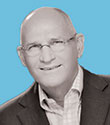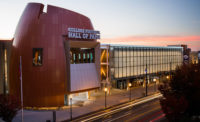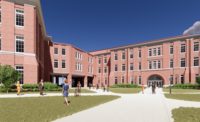
P. Michael
Reininger
When, on Aug. 5, a Florida state board approved All Aboard Florida’s request to issue $1.75 billion in tax-exempt bonds to fund its planned 235-mile passenger-rail project, it signaled a key milestone for the company developing the Miami-to-Orlando transportation system.
Now rebranded as Brightline, the Coral Gables-based division of rail baron Henry Flagler’s old company is forging ahead with its controversial $2.5-billion project, with construction underway at stations in Miami, Fort Lauderdale and West Palm Beach. Led by President P. Michael Reininger, the company also has hired Archer Western Contractors to manage construction of 66.5-mile, Miami-to-West Palm Beach segment—to be built mostly upon existing infrastructure—and oversee railway and related work at Orlando International Airport, the line’s other terminus.
![]() The 168.5-mile, West Palm Beach-to-Orlando segment—similarly located upon company-owned right of way—generated pushback from opponents who criticized Brightline’s planned use of a $1.5-billion federal loan. To overcome that criticism, the company switched to bonds. So far, market headwinds have slowed the bond sale, prompting a 12-month extension, recently granted.
The 168.5-mile, West Palm Beach-to-Orlando segment—similarly located upon company-owned right of way—generated pushback from opponents who criticized Brightline’s planned use of a $1.5-billion federal loan. To overcome that criticism, the company switched to bonds. So far, market headwinds have slowed the bond sale, prompting a 12-month extension, recently granted.
The company remains publicly undaunted in its quest. “We remain committed to delivering service from Miami to Orlando and have made significant advancement with our construction to begin Brightline operations in 2017,” states Reininger, an architect by trade.
Characterizing the project as a response to market demand for more and better transit options, Reininger adds, “As people around the country are increasingly relocating to the urban core, the need for reliable and convenient transportation continues to grow.”
“This is a big, big deal,” says Ananth Prasad, Florida’s former transportation secretary and now senior vice president with project consultant HNTB. Calling it a “unique model,” the 2014 ENR Newsmaker compares the effort to the introduction of the interstate highway system. Prasad adds that the relative cost-effectiveness of expanding upon existing infrastructure, as opposed to green-field development, could prove to be a trend.
“We need this to be successful so that people can see that it can be done,” Prasad says. “If it proves to be financially viable, it gives hope that there’s a path forward.”





Post a comment to this article
Report Abusive Comment